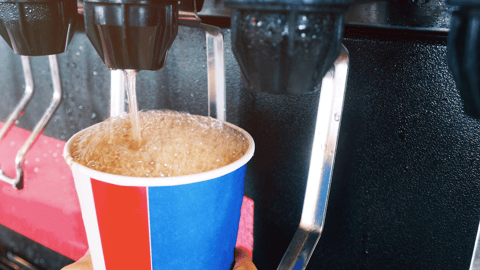CSNC EXCLUSIVE: Convenience store customers crave sugar-free snacks and beverages
Flavoured beverages and candy bars on c-store shelves are known for sugar highs. But there are sweet rewards for c-stores that also carry reduced or no added sugar alternatives: sales growth in the coming years.
Valued at US$19.17 billion in 2023, the sugar-free food and beverage market’s value globally will top US$23.3 billion by 2028, for a CAGR of 3.98%, estimates Mordor Intelligence.
Growth is being fuelled by consumers learning about the dangers of excess sugar in their diets, from obesity and diabetes to high blood pressure.
“A reduced sugar diet has been a trend for several years, as sugar is the most demonized ingredient for its health risks,” says Shelley Balanko, senior vice-president of The Hartman Group.
According to the market researcher’s Health and Wellness 2023 report, 62% of U.S. consumers are seeking to decrease their sugar intake, more so than any other ingredient, including sodium (58%) and fat (55%).
Age matters
Half of both millennials and gen X and 59% of boomers also look at the nutritional panel on products, according to The Hartman Group’s Taste of Tomorrow 2023 report. Of this panel-eyeing segment, 67% of millennials, 69% of gen X and 77% of boomers are looking at the sugar content, more so than any other nutritional fact.
While less than half of gen Z look at nutrition panels (43%, with 62% of this group looking at sugar amounts), that has to do with their life stage of eating what they want, and will no doubt turn to c-stores for health-conscious options.
“Younger generations haven’t grown up with this expectation that, ‘You get junk food from convenience, healthy food from grocers and cheaper options from mass retailers,’” says Balanko, noting c-stores expanded foodservice with healthier options. “They’re channel agnostic, expecting all types of retailers should provide them with what they want.”
Permissible indulgence
An Ipsos FIVE Syndicated Study, meanwhile, shows that for candy, chocolate and commercial beverages, the label “No Sugar Added” on average has grown by 29% in the past five years in share of occurrences (R12ME November 2023 vs R12ME November 2019).
“This addresses the reduced frequency of consumers buying sugary products,” says Mauricio Yin Vieira, vice-president, market strategy and understanding at Ipsos.
He also notes the rise of "permissible indulgence,” a trend wherein consumers opt for sweetened products that offer functional benefits or replace natural sweeteners such as honey, maple syrup or Stevia for sugar.
No Sugar Company, a brand started by Canadian entrepreneur Brad Woodgate in 2018, has had success in the gas and c-store channel with its sugar-free energy beverage brand, Joyburst. About 40% of Joyburst’s sales in Canada and the U.S. are generated there.
No Sugar Company is turning attention to the channel in expanding its sugar alternative snacks, like Chocolate Caramel and Chocolate Peanut Butter keto bars. Their 100% year-over-year increase in sales has mostly been at mass and drug retailers, “and we think it can be very disruptive in gas and convenience,” explains Woodgate.
He notes the price of the average candy bar has crept up because of inflation to within about $.50 cents of No Sugar Company bars. “If it’s only a small price difference, consumers will make that trade for the health benefits,” says Woodgate. The added benefit for the company? With trial, more consumers will also discover no sugar products can taste good, too, and will potentially purchase in bulk at other retailers.
While No Sugar Company can’t compete with the massive marketing budgets of multinational brands, he says the company is looking at advertising promotions on the back of receipts and will partner for the third consecutive year with the Heart and Stroke Foundation on National No Sugar Day, which is Oct. 3.
Category growth
A large portion of lozenges in c-stores also contain sugar, making them as much candy as medicated tablets.
Brands like Bentasil propose an antidote, with sugar-free lozenges in flavours highlighting other cold-fighting or throat-soothing properties–eucalyptus, blackcurrant and honey lemon. They also have a soft texture, allowing for it to be chewed or sucked.
While Bentasil has been around for 30 years, mostly in pharmacy retailers, “it had never really made its way into convenience,” says Mark Elliott, key account manager at Regal Confections, a distributor of global candy, chocolate and the Bentasil brand in Canada.
That’s changing. The three SKUs recently secured listing in 7-Eleven Canada, where it will be merchandised in the health section alongside cough/cold products and OTC pain relief in 600 stores.
“There is a growing portion of the population that specifically looks for sugar-free alternatives, especially in something that will be in their mouth for an extended period in providing relief from a sore throat,” says Elliott. “We’re really just getting started in the c-store channel and hope to get into other big chains as well.”
The beverage category is also seeing changes in consumption preferences.
That is reflected in a Conference Board of Canada study, The Non-alcoholic Beverage Sector in Canada: A Study of Economic Impact and Consumption, which the Canadian Beverage Association financially supported.
It found the share of low-calorie servings of total non-alcoholic beverage volumes over the past 12 years has steadily increased, from 44% in 2009 to 58% in 2021.
“Low-calorie non-alcoholic beverage servings have outstripped their full-calorie counterparts and become mainstream over the past decade,” reads the report.
And since 2014, the share of low-calorie servings has grown across almost every beverage subcategory, including sports drinks, carbonated soft drinks, caffeinated energy drinks, still drinks, iced/ready-to-drink coffee drinks and juice-containing drinks (nectars).
Caffeinated energy drinks, in particular, got a jolt, with low-calorie servings accounting for 28% of consumption in 2021—almost double what it was in 2014.
Red Bull is among the energy drink brands expanding their portfolios with no sugar options. In January, it launched Red Bull Red Edition Sugarfree and Red Bull Apricot Edition Sugarfree nationwide.
Red Bull directed an interview request to the CBA, which has been leading an effort launched in 2014, called the Balanced Calories Initiative, (BCI) in partnership with the federal government, to reduce the number of calories Canadians consume from non-alcoholic beverages by 20% by 2025.
That requires more product with less sugar, which is what fuels high calorie counts in beverages.
“BCI is about providing consumers with more choices,” says Erich Schmidt, director, comms and public affairs at the CBA. “We believe that consumers shouldn’t have to change their beverage choices, but rather be provided with options through product innovation, thereby ensuring consumers have access to low and no-calorie products.”







